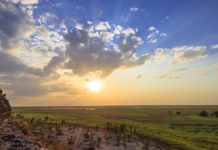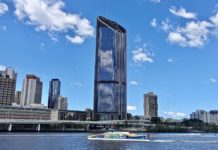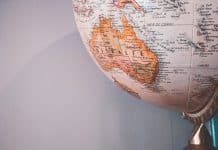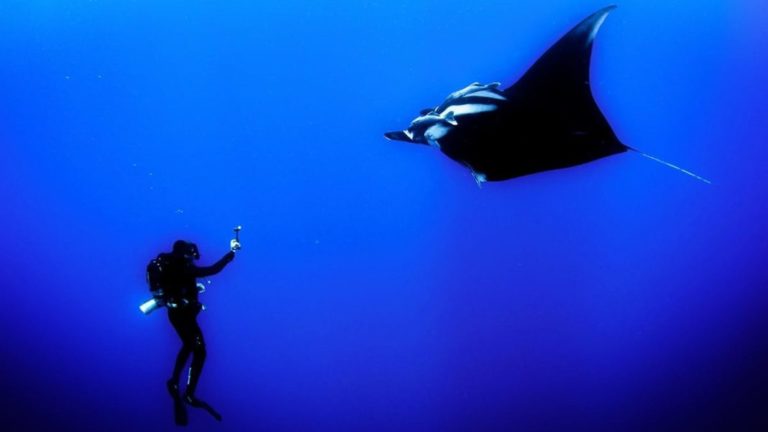
Nestled between the Indian Ocean and the Pacific, Australia is known to divers around the world for its turquoise waters, coral reefs and the abundance of wildlife. Not to mention the ideal climate for diving all year round – it would be a shame to deprive yourself! If you are a fan of scuba diving and hold the relevant certificate, you will be spoiled for choice so here is our selection of the best diving spots in Australia.
Table of Contents
The Great Barrier Reef & Whitsunday Islands (QLD)
Great Barrier Reef
Located 60km off the coast of Queensland this treasure is a must for those wanting to go diving in Australia! The Great Barrier Reef offers the opportunity to go diving on one of the 7 natural wonders in the world and explore a UNESCO World Heritage Site under the sea. Just by looking at it, it’s easy to understand why… White sand, crystal clear waters as far as the eye can see, gigantic coral reefs, colourful fish of all sizes. This marine paradise is a real gem!
It is the largest marine park on the planet, made up of 900 islands and 2,900 coral reefs. In order to appreciate its beauty, opt for a “liveaboard dive trip” which will allow you to dive several times and explore different reefs.
You will likely find sea turtles, manta rays, groupers, dolphins, sharks and even whales for the lucky ones, as well as more than 400 species of coral.
🐠 Popular Diving Sites
- Cod Hole: Known for its friendly giant groupers.
- Osprey Reef: Perfect for seeing sharks and vertical coral walls.
- Ribbon Reefs: Ideal for drift dives and pristine reefs.
🗓️ The best time to dive on the Great Barrier Reef is between mid-August and mid-December. The conditions are excellent during this period!
There are several diving centres in the region, such as:
- www.prodive.com.au
- www.divingcairns.com.au
www.tusadive.com - www.greatadventures.com.au
- www.quicksilver-cruises.com
Whitsunday Islands
🗓️ The climate of the Whitsundays is good all year round. In summer, outside temperature is around 30°C, while in winter it drops to around 23°C. The water temperature is 25°C all year round. Thanks to its amazing climate, you have the opportunity to dive throughout the year. The whale season extends from June to November and that the rainy season goes from January to March. A few episodes of heavy rain occur during this period but nothing prevents you from diving if it is not an inconvenience for you.
🐠 Popular Diving Sites
- Blue Pearl Bay: Known for its coral gardens and tropical fish.
- Hardy Reef: Offers dives on beautiful reefs with exceptional visibility.
- Hook Island: Features dives in underwater caves and canyons.
- The Woodpile and Luncheon Bay are two very pretty scuba diving sites.
The Woodpile is one of the best dive walls in the Whitsundays. However, it is not recommended to go there when there is a current or on windy days. At Luncheon Bay (north end of Hook Island) you can explore caves and crevices (20m deep). You will see plenty of reef fish, but also Maori wrasse, groupers, sweetlips, as well as moray eels, coral trout and nudibranchs. You will also find (common) white tip reef sharks, turtles and sometimes Manta rays.
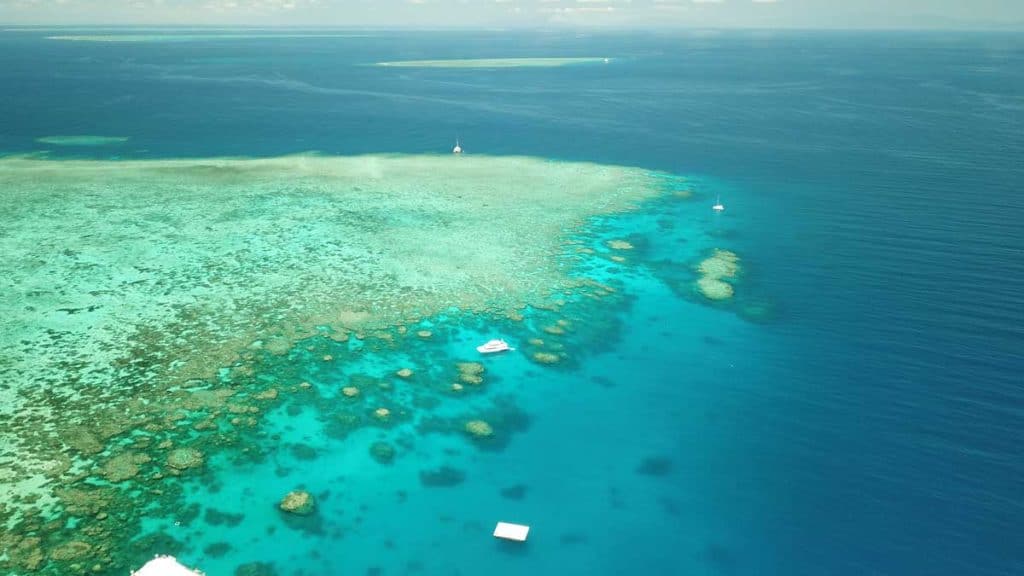
Yongala wreck in Townsville (QLD)
The Yongala Wreck is in the central section of the Great Barrier Reef Marine Park. This ship SS Yongala sank off Cape Bowling Green in 1911. It was making the Melbourne -Cairns route, and sank south of Townsville trying to escape a tropical cyclone. This wreck is one of the best scuba diving sites in the world and in Australia! There is often a strong current, which is why this underwater spot is only for experienced divers! Even after more than 100 years underwater, the wreck of the Yongala is in good condition.
🐠 The marine life there is simply amazing: giant groupers, eagle rays and manta rays, sea turtles, sea snakes, barracudas as well as various species of sharks (such as bulldog sharks and tiger sharks). Between June and November, you may be lucky enough to spot Minke whales or humpback whales. You could also come face to face with a whale shark between October and January. You will be amazed! This dive spot is an excellent place for underwater photography, so don’t forget your camera!
Lady Elliot Island (QLD)
Nicknamed “Home of the Manta Ray”, Lady Elliot Island is the perfect destination for swimming with these magnificent creatures. The island is accessible from the city of Bundaberg in Queensland. It has been part of the “green zone” since 2005 which means fishing is prohibited allowing marine life to thrive.
With visibility over 20m, it is one of the best diving spots in Australia for a fully immersive, 360 ° experience!
🗓️ Manta rays are present all year round but flock during the winter months! Curious in nature, they will “dance” around you and leave you mesmerised! From May to October, you will even have the chance to spot whales as they migrate during the cooler months.
You can find more information on all the diving spots offered on Lady Elliot island here: www.ladyelliot.com.au
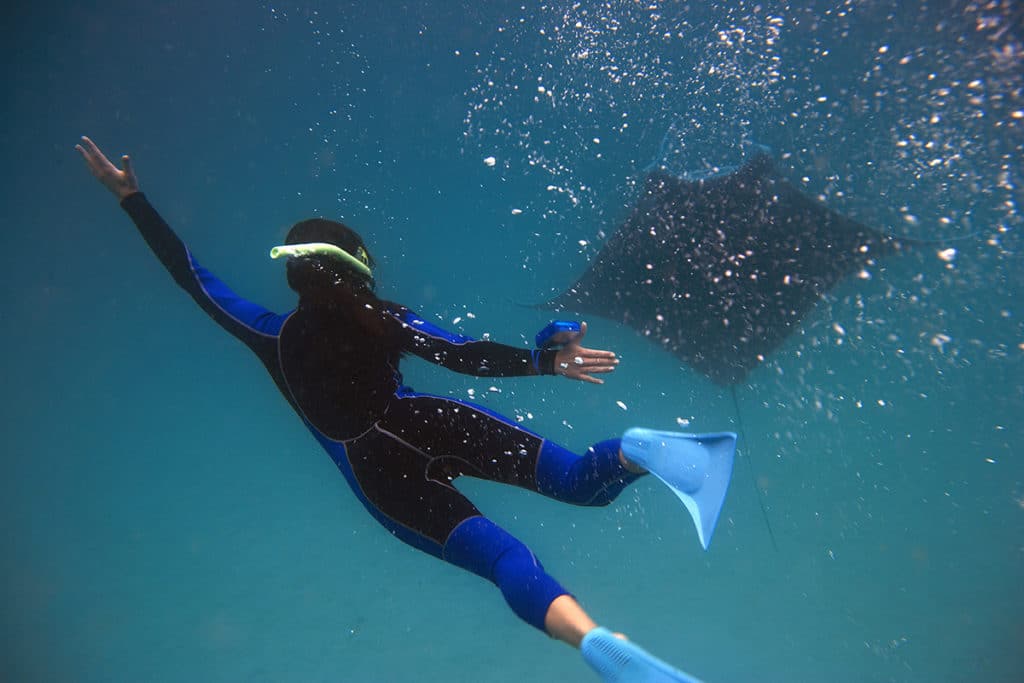
Moreton Island & Tangalooma wrecks (QLD)
Located off the coast of Brisbane, on the island of Moreton, you will find the Tangalooma Wrecks site which hosts 15 shipwrecks. You can get there via ferry which takes just 75 minutes from the city. Tangalooma means “where the fish meet” in the aboriginal language which is an apt title for this unusual place which has an underwater community composed of sumptuous corals and a hundred species of fish. It is also possible to spot dolphins and the lovable dugongs, tenderly nicknamed “sea cows”. This dive is accessible to beginners as well as experienced divers and will not fail in providing unforgettable memories.
After exploring under the sea, take advantage of your time on Moreton Island which is ranked 3rd largest sand island in the world. Dry off by exploring the dunes on a rented quad or surf them on a sandboard!
For more info: www.tangalooma.com

Kangaroo Island (SA)
Kangaroo Island, located off the southern coast of South Australia, is renowned for its natural beauty and exceptional diving opportunities.
🐠 Popular Diving Sites
- The Dredge: A popular wreck teeming with marine life, resting at a depth of 20 meters.
- The Grecian: A sunken wooden cargo ship that provides a habitat for a variety of marine life.
- Kingscote Jetty: Perfect for spotting leafy sea dragons.
- Vivonne Bay: Known for its crystal-clear waters and underwater rock formations.
Additionally, the waters surrounding the island host magnificent coral gardens. Divers can explore colorful coral formations, underwater caves, and natural arches covered with both soft and hard corals. The corals harbor a wide variety of tropical fish, crustaceans, and other marine creatures.
One of the unique experiences you can have while diving off Kangaroo Island is encountering Australian fur seals and dolphins. These curious and playful animals are often present in the surrounding waters and can interact with divers, providing unforgettable moments.
Neptune Islands and the great white sharks (South Australia)
From Port Lincoln, Rodney Fox Shark Expedition is the only center in the world to offer cage diving with the great white shark. The cage can accommodate 3 divers and descends to the depths on the outskirts of Neptune islands.
It is an incredible experience to be able to observe them in their natural environment whilst having the opportunity of an unforgettable face to face encounter with this fascinating animal.
This unique expedition also offers courses in biology and ecology for those wanting to heighten their knowledge of the marine eco-system. Led by Professor Alessandro de Maddalena, a global shark expert. You will learn more about the great white shark, its lifestyle and its behaviour. Do not hesitate to ask him all the questions that run through your head!
To book this incredible dive, visit the website: www.rodneyfox.com.au

Ningaloo Reef (Western Australia)
Ningaloo Reef, a UNESCO World Heritage site, is famous for its whale sharks, manta rays, and dugongs. This fringing reef is easily accessible from the coast, making it perfect for diving and snorkeling.
🐠 Popular Diving Sites
- Navy Pier: This dive is located at the still-active Navy Pier military base in Exmouth. Only a few companies are authorized to dive here under very strict conditions. The Exmouth Navy Pier site is renowned for its rich marine life. Giant groupers, nurse sharks, lionfish, moray eels, barracudas, nudibranchs, and many other fish can be observed at the site. It is an easy dive conducted in shallow waters (less than 10 meters) with access from the shore. It will delight both beginner and experienced divers. For even more thrills, opt for a night dive and let yourself be transported by this incredible place. Dive Ningaloo and Exmouth Dive and Whalesharks Ningaloo both offer excellent diving experiences.
- Lighthouse Bay: An ideal spot to observe turtles and reef sharks.
- Muiron Islands: Offer underwater caves and rich marine life.
Christmas Island (between Australia and Indonesia)
Christmas Island is a small Australian territory of 135 km2, located in the Indian Ocean, south of Indonesia. You should know that Christmas Island is one of the best scuba diving destinations in Australia. Indeed, you can find more than 60 different dive sites in this little eldorado.
This small island is perfectly located at the edge of the deepest trench in the Indian Ocean. Its coral reef is a fringing reef with some walls tumbling over several kilometres. They are among the biggest in the world. Most of the walls are accessible from the shore (about twenty meters away) and are therefore easily reachable by divers of all levels. Another positive point: underwater, visibility is always excellent (up to about 50 meters).
🐠 Christmas Island has an amazing diversity of marine life. Indeed, 88 species of coral and more than 650 different fish have taken up residence in this sanctuary. The coastline is home to some of the most intact corals in the world, including gigantic plate and fan corals. Here live in harmony surgeonfish, wrasse, butterflyfish, angelfish, groupers, but also parrotfish, eels and countless other species. That’s not all, you can also observe tuna, marlin, swordfish, rainbow steed and barracuda.
Don’t miss reef sharks or hammerhead sharks, manta rays, sea turtles and dolphins.
🗓️ If you choose to dive between November and April, you will certainly have the chance to come across whale sharks. And if you are extremely lucky, you may come across a moonfish! They lurk in the depths and weigh up to 1 ton.
Practical Information
The practice of scuba diving is a wonderful activity however all divers should be aware of the necessary precautions :
- It is necessary to have a recognized diving certificate such as PADI or SSI. You can pass your Openwater diver diploma in just a few days.
- It is recommended to allow a gap of minimum 12h before diving following a flight to allow your body to adjust.
- Book your dives only in approved centres
- Learn about the country’s climatic conditions and seasons
If you wish to pass your diving diploma in Australia there are numerous sites, such as:
- Sydney: divebondi.com.au – www.divesydney.com.au
- Brisbane: www.brisbanediveacademy.com.au
- Cairns: prodivecairns.com
- Melbourne: www.academyofscuba.com.au
- Perth: www.perthocean.com




















